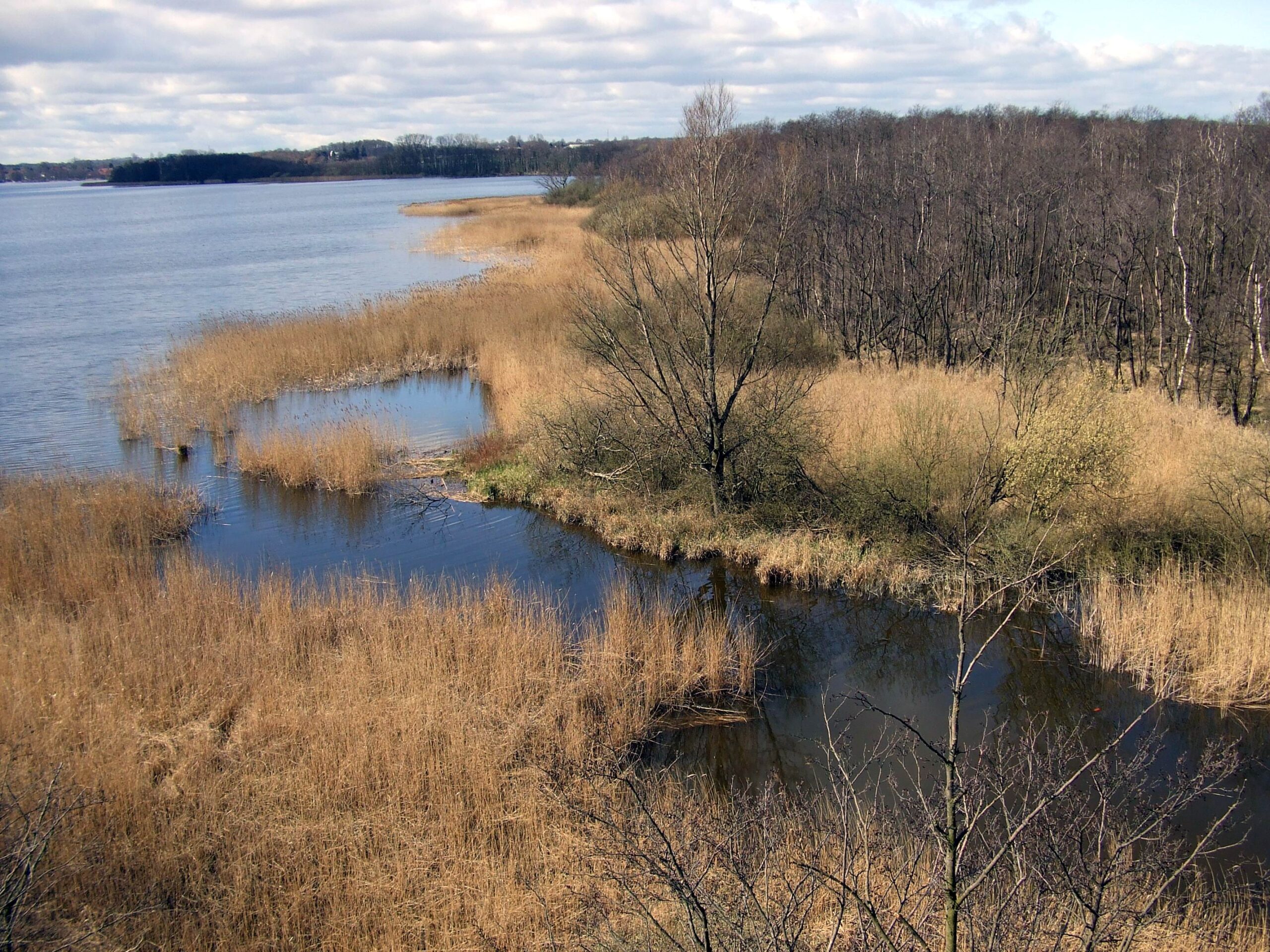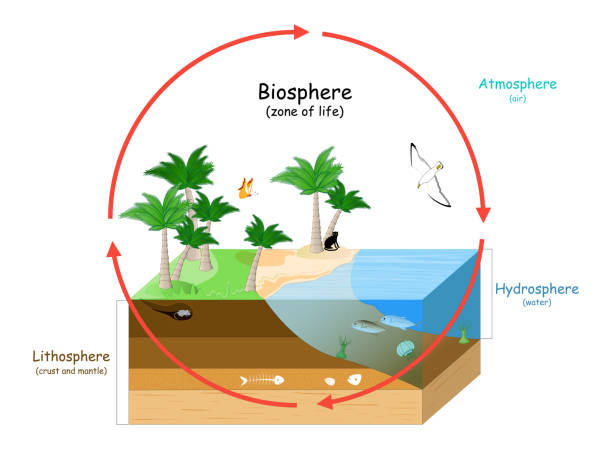Sir Arthur Tansley invented the word ecosystem in 1935. An ecosystem is a biological habitat that includes all live species and non-living things (such as air, soil, and water) in a given area, as well as their interactions.
It is a biosphere structural and functional unit made up by a community of living beings and their physical surroundings, which interact and exchange materials. An ecosystem is a complex web of interconnections between the living resources, environments, and people who live in a given place. An ecosystem can range in size from a single tree to a whole forest.
Components of Ecosystem
The components of the ecosystem are categorized into abiotic and biotic components.
Abiotic Components
- The world’s inorganic and nonliving components are known as abiotic components. Soil, water, air, light energy, and other abiotic elements make up the abiotic component.
- It also involves a variety of substances, such as oxygen and nitrogen, as well as physical events, such as volcanoes, earthquakes, floods, forest fires, temperatures, and weather patterns.
- Rainfall is necessary for all living things. In an aqueous medium, the bulk of biological reactions take occur. Water aids in the regulation of body temperature. Furthermore, many aquatic plants and animals call water bodies home.
- The earth’s atmosphere is responsible for establishing the circumstances necessary for a healthy biosphere to live on this planet. It is composed of 21% oxygen, 78% nitrogen, 0.038 percent carbon dioxide, and other inert gases (0.93 percent Argon, Neon, etc).
- Sunlight provides energy that is necessary for life to exist. In the case of plants, the sun provides all of the energy they require. Because animals cannot directly utilise solar energy, they must receive it through the consumption of plants, animals, or both. The distribution of organisms in the environment is determined by energy.
- Temperature- Temperature is a vital environmental component that has a significant impact on organism survival. Organisms can only endure a limited temperature and humidity range.
Biotic Components
- It is made up of living species such as plants, animals, and bacteria that are divided into producers and consumers based on their functional characteristics.
- Autotrophs (Primary Producers) – Autotrophs are basically green plants (and certain bacteria and algae). They make carbohydrates for themselves by photosynthesis from simple inorganic raw materials like carbon dioxide and water in the presence of sunshine, and they supply indirectly to other non-producers.
- Consumers (Heterotrophs or Phagotrophic) – Consumers are unable to produce food for themselves (photosynthesis). They eat organic food made from plants, animals, or a combination of the two. Consumers are classified into two categories: micro and macro consumers.
- Macroconsumers eat plants, animals, or both, and are classified according to their food sources. Herbivores, such as cows and rabbits, are primary consumers who eat mostly plants. Wolves, for example, are secondary consumers who feed on primary consumers. Tertiary consumers are carnivores that feed on secondary consumers, such as lions that can eat wolves. Omnivores, such as humans, are species that eat both plants and animals.
- Micro consumers (Saprotrophs) are bacteria and fungus that get their energy and nutrients from decaying dead organic matter (detritus) from plants and animals. Producers utilise and recycle breakdown products such as inorganic nutrients that are released into the ecosystem. Detritus feeders, such as earthworms and certain soil creatures, aid in the breakdown of organic materials and are referred to as detrivores.
Classification of Ecosystem
The ecology can be as little as a pond or as huge as a forest or a sea. Many ecologists consider the entire biosphere to be a global ecosystem, made up of all of Earth’s local ecosystems. Because this system is too large and complex to study all at once, it is easier to separate it into two main categories: terrestrial and aquatic.
Terrestrial Ecosystem
The terrestrial ecosystem is defined as an ecosystem that exists solely on landforms. The major feature that distinguishes terrestrial ecosystems from aquatic ecosystems is the relative scarcity of water in terrestrial ecosystems, as well as the importance that water has in these ecosystems as a result of its scarcity.
Another factor is that these ecosystems have more light since the environment is cleaner inland than it is in water. Forest ecosystems, desert ecosystems, grassland ecosystems, and mountain ecosystems are the four basic types of terrestrial ecosystems.
Aquatic Ecosystem
An aquatic ecosystem is a type of ecosystem that thrives in a body of water. Freshwater ecosystems and marine ecosystems are the two basic types of aquatic ecosystems.
Ecotone
An ecotone is a zone where two or more different ecosystems meet. Mangrove forests, for example, are a transition zone between marine and terrestrial ecosystems. Grassland, estuary, and riverside are some other examples. An ecotone can be found along a broad ridge or in a small pocket, such as a woodland clearing, where two local groups collide.

The edge effect refers to the mutual influence of two bordering communities. For activities like courtship, nesting, or food gathering, some creatures require a transitory space. An ecotonal area often contains a higher density of organisms of one species and a bigger number of species than the bordering communities.
Edge Species and the Edge Effect
There would be a species that dominated the other communities in that zone in terms of numbers and population. This is known as the Edge Effect. The species that are plentiful are referred to as Edge Species.
The edge effect is particularly relevant to birds in terrestrial habitats. Bird density is higher in the mixed habitat of the ecotone between the forest and the desert, for example. The Keoladeo Ghana national park, for example, forms an ecotone between the Aravallis’ highland forests and the Thar Desert in the northwest.
Habitat
The distribution of a species’ ecological niche in relation to its habitat, which is the name given to the place where an organism lives, might vary. Individuals’ roles will be influenced by factors such as the availability of various diets and competition from other species. Man is an example of this, as he alternates between being a herbivore, carnivore, and omnivore in different environments.
Niche
A species’ particular functional role or place in an ecosystem is referred to as a niche. The physical environment to which a species has adapted, as well as its position as a producer and consumer of food resources, make up a species’ niche.
It’s a list of all the biological, physical, and chemical elements that a species requires to exist, stay healthy, and reproduce. A niche is unique to a species, meaning no two species have niches that are exactly alike. In the conservation of species, niche plays a crucial role.
Niche Categories
- It resides in a habitat niche.
- What it eats or decomposes, as well as what species it competes with, make up its food niche.
- How and when it reproduces is the reproductive niche.
- Temperature, landform, land slope, humidity, and other needs are all part of the physical and chemical niche.
Biome
A biome is a huge natural community of plants and fauna that inhabits a large environment. The desert biome, rainforest biome, Savannah biome, and others are some of the most well-known biomes on the planet.
Plants and animals in a biome share shared traits due to dominant vegetation types, similar weather, and the fact that they may be found on a variety of continents. Temperature and precipitation are the most important climatic elements. Biomes differ from habitats in that they can contain a range of habitats.
Biosphere

The biosphere is made up of all of the earth’s terrestrial biomes and marine systems on a global scale. The biosphere is an area of the earth that can support life. The atmosphere (air), hydrosphere (water), and lithosphere (rock) make up the biosphere, which is a highly integrated and interacting zone (land).
It’s a thin layer that wraps around the earth’s surface. Between 200 meters (660 feet) below the ocean’s surface and 6,000 meters (20,000 feet) above sea level, the biosphere is teeming with life. At the North and South poles, the tallest mountains, and the deepest oceans, the biosphere is missing.
The biosphere does not have a uniform distribution of living creatures. The Polar Regions are home to only a few creatures, but tropical rain forests are home to a vast array of plants and animals.

